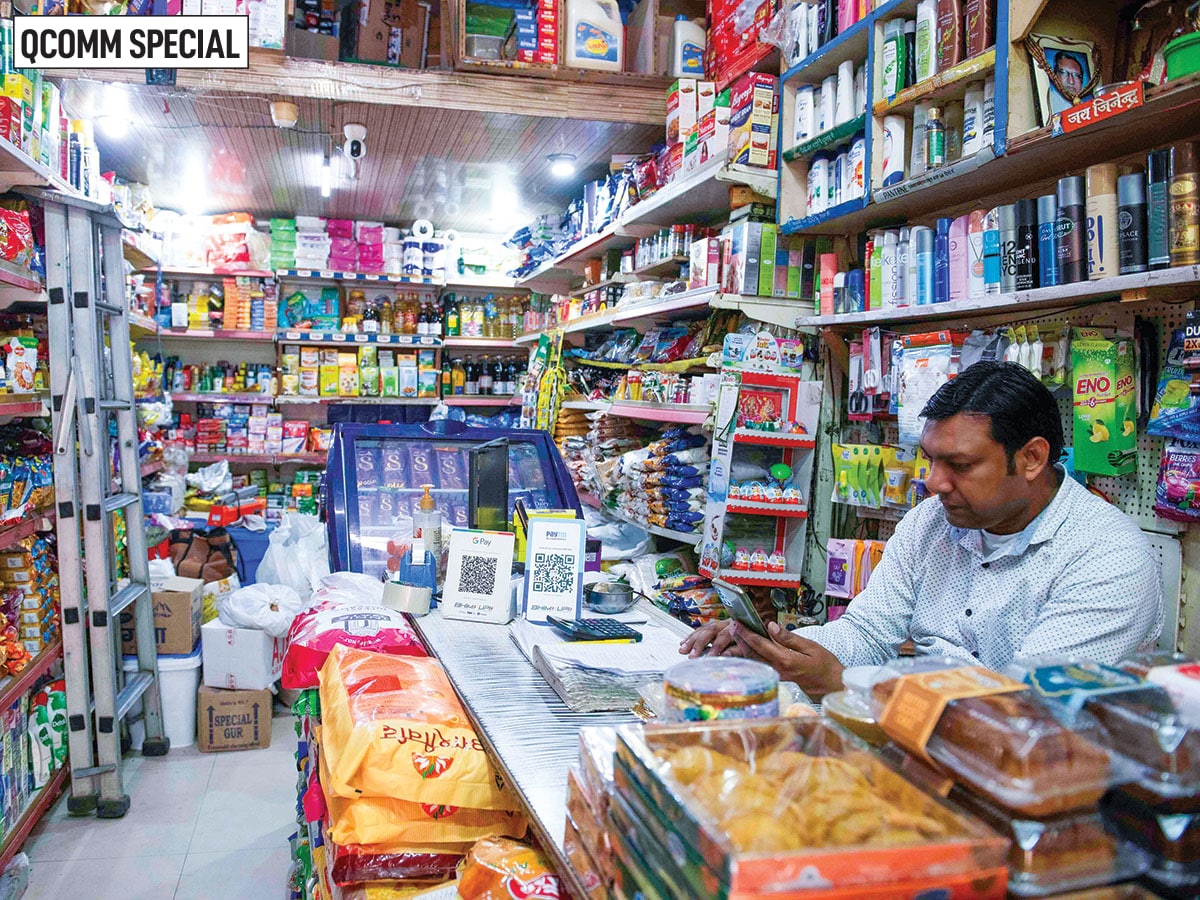 Grocery stores, such as this one in Dwarka, New Delhi, are experiencing lower purchase volumes amid the rise of quick commerce
Grocery stores, such as this one in Dwarka, New Delhi, are experiencing lower purchase volumes amid the rise of quick commerce
Image: Amit Verma
It is 12.30 AM. Spandana Eslavath, a 26-year-old mother in Bengaluru, is home alone, tending to her daughter who is suffering from severe food poisoning. Realising she is out of ORS, Eslavath opens Flipkart Minutes on her phone. A few taps later, help is on the way. Within 10 minutes, a rider hands over the much-needed solution at her doorstep—a moment of relief during a night of stress.
It is 7.30 AM. In another corner of the city, Sunita Mittal, a 58-year-old homemaker, discovers she is out of cooking oil. With no time to waste, she turns to Swiggy Instamart. The missing ingredient arrives in 15 minutes, saving her morning from chaos.
It’s 8.30 AM. Spandana, who works as a cook in the Mittal home, is discussing with Sunita, over steaming cups of tea, how quick commerce (QComm) apps have quietly become indispensable to them. They marvel at how a few taps on the phone can bridge gaps that once caused panic.
QComm was not always a subject of conversations over morning tea. When the likes of Blinkit, Zomato’s QComm arm, and Zepto first started making claims of 10-minute deliveries, an often-asked question was whether anyone really needed grocery and other everyday items delivered so fast. Now every QComm player is talking 10-minute deliveries and BigBasket claims to have delivered within six in some areas.
As deliveries have become quicker, they have tapped a consumer need no one knew existed, which is to get anything from pepper to PlayStation within minutes of realising you needed it. No wonder the sector is expanding rapidly, with growth rates estimated at a staggering 75-100 percent year-on-year, according to a Bernstein report. Experts suggest QComm is set to outpace traditional retail models.
Traditional ecommerce players such as Flipkart and Amazon are jumping on the QComm bandwagon with Flipkart Minutes and Amazon Now. “Amazon has always focussed on offering customers a wide selection with convenient and fast delivery. We are always innovating to offer even more value to customers. Amazon Now is a limited pilot in select PIN codes of Bengaluru and a trial to offer even faster speeds on a selection of everyday essentials from our sellers that customers often need quickly,” an Amazon spokesperson told Forbes India.
But delivery times are shrinking at a cost—literally.
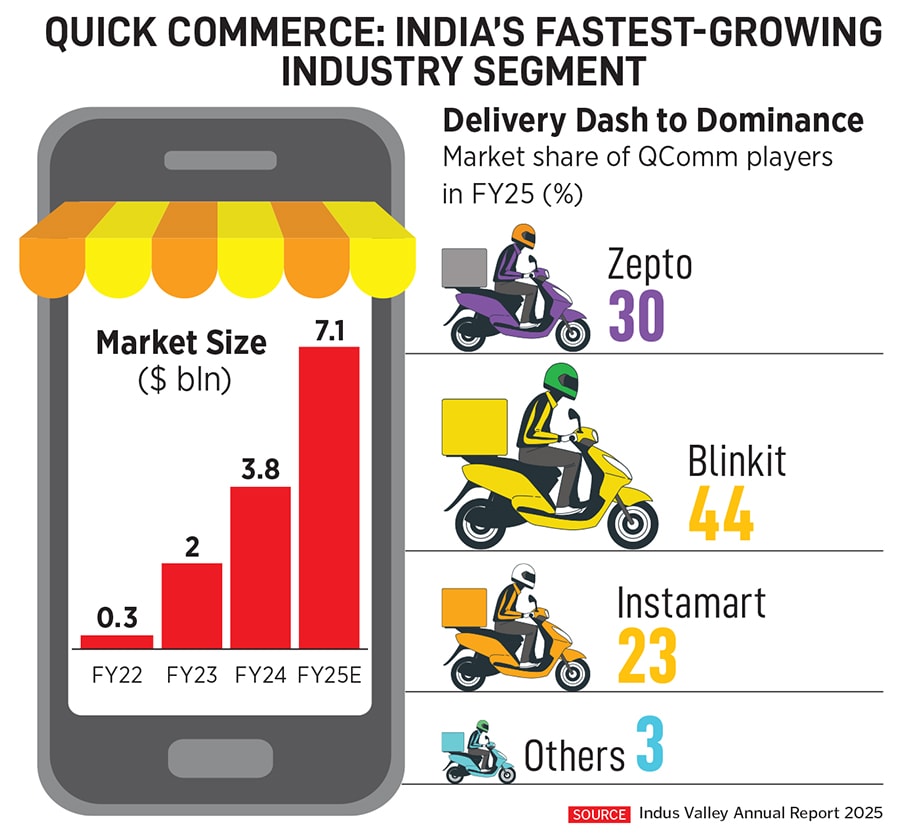
Getting Burned
QComm industry’s burn rate—a measure of the reserves being spent before a company begins to generate positive cash flows—is said to be in the range of ₹1,300-1,500 crore every month. Some wonder if QComm is just a passing fad, an unsustainable business running on the fumes of investor money, like edtech appeared to be doing until Byju’s began to flame out.
Many QComm players are currently burning through vast amounts of cash to capture market share. Zepto, which is sitting on a pile of $1.3 billion, is splurging on acquiring customers, forcing rivals such as Zomato and Swiggy to burn cash as well. Zomato has invested ₹1,500 crore in its QComm arm, Blinkit. Swiggy has announced plans to invest ₹1,000 crore in QComm, adding to an earlier infusion of ₹1,600 crore.
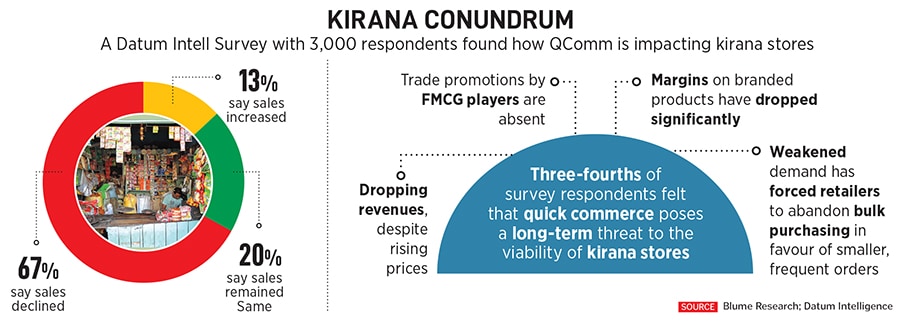
A significant portion of these investments is directed at expanding dark stores to support the growing demand. Analysts project the number of dark stores to surge from 3,400 in FY25 to 11,150 by FY31. But a recent Blume report raises concerns about their feasibility.
The report says only 965 of India’s 19,300 postal codes are affluent enough to sustain dark stores, casting doubts on the scalability of the model. With orders per dark store stabilising, the report cautions that “the aggressive projections of total orders seem a tad unrealistic.”
QComm operators are expanding beyond the metros into tier 2 cities, such as Bathinda, Haridwar, Jammu, Kochi, Rajkot and Bhopal. Blinkit, Instamart, and Zepto are present in 70 to 85 cities. However, Albinder Singh Dhindsa, founder and CEO of Blinkit, said during an analyst call in the third quarter of FY25 that 80 percent of Blinkit’s sales came from just eight cities.
Can this cash-intensive strategy deliver long-term returns?
Also read: 2024: The year when quick commerce took off
Winning In India
Unlike developed nations, such as the United States and United Kingdom, where modern retail dominates with an 80 percent market share, India’s modern retail penetration is a mere 6 percent. This provides QComm the opportunity to leverage existing infrastructure and robust supply chains to ensure rapid fulfilment and operational efficiency.
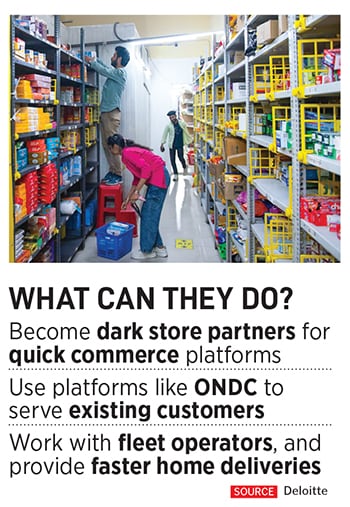 “India’s densely populated urban areas create a favourable environment for quick commerce. And most importantly, an abundant supply of affordable labour plays a pivotal role in the success of quick commerce by enabling cost-effective operations,” says Praveen Govindu, Partner at Deloitte India.
“India’s densely populated urban areas create a favourable environment for quick commerce. And most importantly, an abundant supply of affordable labour plays a pivotal role in the success of quick commerce by enabling cost-effective operations,” says Praveen Govindu, Partner at Deloitte India.
India’s burgeoning population of tech-savvy millennials and Gen Z, coupled with a large middle class, has fueled QComm’s rapid expansion by prioritising speed and convenience. “Given that India’s Gen Z and millennial population is driving this growth, they prefer convenience and are also big on impulse purchases. This, topped with reasonable discounts, makes it a great offering,” says Karan Taurani, senior vice president- research analyst, at Elara Capital.
That comes with consequences in a country where daily visits to the local kirana store have been a tradition. When Forbes India reached out to kirana store owners across cities, most were reluctant to speak on record. Yet, the sentiment was unanimous: QComm has taken a toll on their businesses.
Last November, according to Datum Intelligence, 46 percent of consumers surveyed reported reduced spending at kirana shops, indicating a shift towards QComm platforms. More than 82 percent had shifted at least a fourth of their grocery purchases from kirana to QComm.
In October, reports quoted the All India Consumer Products Distributors Federation (AICPDF) as saying that 200,000 kirana stores had shut shop in the previous year. AICPDF and kirana stores are believed to have moved the Competition Commission of India, the fair trade regulator, on February 28, alleging unfair practices by QComm platforms.
Govindu of Deloitte says: “Traditional retailers will have to evolve to match up to customer expectations set by quick commerce platforms by adopting innovative strategies and faster on-ground execution to remain competitive. For instance, kirana store owners with self-owned property can become dark store partners for QComm platforms.”
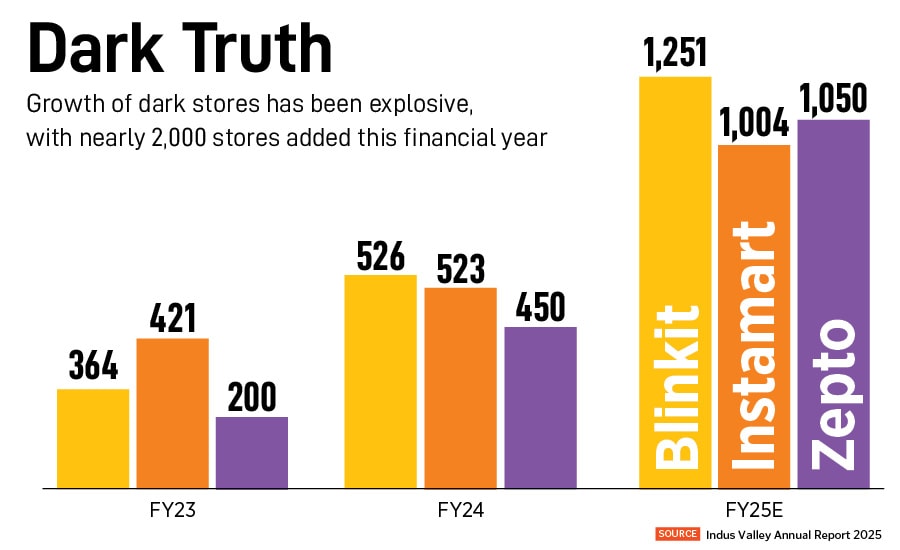
Race To The Bottom?
QComm players are burning cash to increase demand and supply. For demand, says Sajith Pai, Partner, Blume Ventures, “You need to acquire customers, either by giving them deep discounts or spending on marketing.” On the supply side, “they need to invest in expanding the number of SKUs and set up dark stores, ahead of the demand and the workforce behind it. These are the only ways for them to grow.”
SKUs is short for stock keeping units, which are an indicator to track a retailer’s inventory.
In a recent interview with the Economic Times, Deepinder Goyal, CEO of Zomato, said: “It’s about making sure that the discipline of execution stays intact in the team. Our burn rate is 2-3 percent of the sector, while our category share would be 40-45 percent.” Zomato’s QComm arm Blinkit, he said, burned approximately ₹35 crore per month on average last quarter.
He also claimed that the total quarterly burn for the QComm industry was around ₹5,000 crore, adding, “Substantially more than half of this is by Zepto…” Aadit Palicha, co-founder and CEO of Zepto, took to LinkedIn to counter Goyal’s claim. “This statement is verifiably untrue and it will be clear when we publicly file our financial statements,” he said.
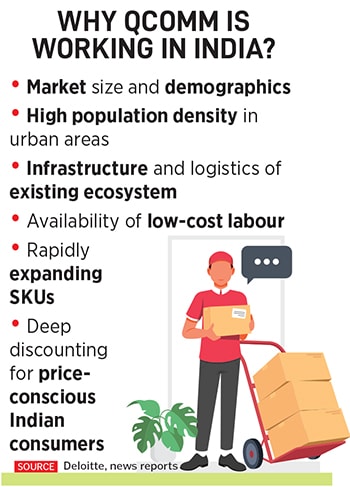
There are others who believe Zepto, which plans to go public in 2025, is investing a lot in customer acquisition. “Zepto has to aggressively invest in growth and customer acquisition, because once they get listed, it will be a lot harder for them to grow like this,” says Pai of Blume.
Though this aggressive spending is crucial for short-term market capture, Govindu says, “the sustainability of such high cash burn depends on transitioning to profitability through cost optimisation and increasing order values.”
Many experts call the growth prospects of QComm “irrational exuberance”. Govindu says that although the high cash burn may appear to be irrational exuberance, it reflects a calculated risk based on the market’s immense potential.
Deepak Sharma, principal, Kearney believes QComm is here to stay. “Though the initial phase is characterised by aggressive customer acquisition, fuelled by substantial investment, the underlying trend is clear: A significant portion of future retail growth will stem from this channel,” he says. “We anticipate that the current investment in building market share, coupled with increasing customer retention rates evident in mature markets, will yield substantial long-term returns.”
In the short term, though, it will soothe a lot a nerves invested in QComm if, in the midst of the shifting consumer behaviour and investor enthusiasm, QComm could shine the torch on a path of profitability while there is still some cash left to burn.
